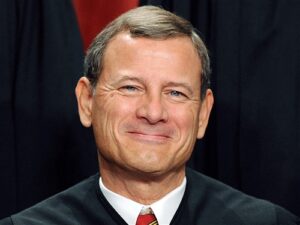With the D.C. Circuit Court of Appeals and the 4th Circuit Court of Appeals issuing contradictory rulings on the question of whether Obamacare exchange subsidies can be given in states that decided to not set up their own exchanges under an IRS regulation, it appears all but inevitable that the case will ultimately wind up in the Supreme Court.
And once again, it may come down to how Chief Justice John Roberts reads the law. Roberts, a George W. Bush appointee, was the swing vote that upheld Obamacare’s individual mandate in National Federation of Independent Businesses v. Sebelius (2012).
At issue — and both the D.C. Circuit and the 4th Circuit agree on this count — the law only ever explicitly authorized some $800 billion a year of subsidies to private insurers be paid through exchanges “established by [a] state.” As it turns out, 36 states have opted not to set up their own exchanges.
Therefore, said the D.C. Circuit, those states cannot receive subsidies under the law: “The problem confronting the IRS Rule is that subsidies also turn on a third attribute of Exchanges: who established them. Under section 36B, subsidies are available only for plans ‘enrolled in through an Exchange established by the State under section 1311 of the [ACA]’… Of the three elements of that provision — (1)an Exchange (2)established by the State (3)under section 1311 — federal Exchanges satisfy only two: they are Exchanges established under section 1311. Nothing in section 1321 deems federally-established Exchanges to be ‘Exchange[s] established by the State.’”
The potential trouble for Obamacare opponents going forward may be that even the D.C. Circuit agrees with elements (1) and (3), that federal exchanges are exchanges established under section 1311. As far as textual analysis goes, then, everything will hinge on item (2), that they must be established by a state to qualify for subsidies, right?
But consider how casually the 4th Circuit disregards element (2) from the D.C. Circuit’s decision. On this count the 4th Circuit said: “To [appellants], ‘established by the State’ in the premium tax credits calculation subprovision is the sine qua non of this case… ’[E]stablished by the State’ indeed means established by the state — except when it does not, i.e., except when a state has failed to establish an Exchange and when the Secretary, charged with acting pursuant to a contingency for which Congress planned, id. § 1321(c), establishes and operates the Exchange in place of the state. When a state elects not to establish an Exchange, the contingency provision authorizes federal officials to establish and operate ‘such Exchange’ and to take any action adjunct to doing so.”
Here, the 4th Circuit clearly used the D.C. Circuit’s elements (1) and (3) to justify its reading and to satisfy condition (2) that any exchange that has been established, whether by the federal government or a state, will for the purposes of the law have been established by a state and therefore qualifies for the subsidies.
Agree or disagree, that appears to be the direction the case is headed when it reaches the full D.C. Circuit and ultimately, if it ever gets there, the Supreme Court.
So how might the nation’s highest court rule?
Even if the Supreme Court were inclined to agree with the D.C. Circuit’s textual analysis on (2), because of (1) and (3), they might still say the provisions are contradictory and therefore lead to ambiguous interpretation, leading to the agency gaining deference under Chevron U.S.A., Inc. v. Natural Resources Defense Council, Inc. (1984). In that case, the Supreme Court decided “[I]f the statute is silent or ambiguous with respect to the specific question, the issue for the court is whether the agency’s answer is based on a permissible construction of the statute.”
This author happens to believe there is no ambiguity at all — “established by [a] state” means what it says — but then again, who would have thought that a penalty that Congress and the President explicitly intended not to be a tax would be treated as a tax by the courts?
So, the Halbig plaintiffs may need something besides the plain meaning of the text of the law to hang their hats on, such as legislative intent, to win the case. On that count, the D.C. Circuit ruling is not very helpful, writing, “the legislative record provides little indication one way or the other of congressional intent.” That is something both the D.C. Circuit and 4th Circuit agreed on.
Unless something else turns up on intent — that is, a statement by a legislator not already in the court record indicating the state exchanges were meant to be incentives to receive subsidies — there may be little reason to have any faith that Chief Justice John Roberts will not use the same legal gymnastics the 4th Circuit utilized to say an exchange in fact established by the federal government was, for the purposes of the law, “established by [a] state.”
Roberts is, after all, the one responsible for transforming the individual mandate penalty into a tax in Sebelius.
If there is any silver lining to what may be the inevitable legal outcome in these cases — opponents of Obamacare lose again — it would be if courts determine the statute is ambiguous on whether federal exchanges can issue subsidies. Why would that be potentially helpful?
Because then, the agency has deference and therefore discretion in constructing regulations now and, importantly, in the future. Therefore, even if the Halbig plaintiffs do not prevail on the ultimate question of whether federal exchanges can issue the subsidies, a potential down-the-road solution might be for a Republican administration to simply issue another regulation that denies the subsidies being given through the federal exchanges.
It is not the optimal outcome, but if Roberts ultimately rules that $800 billion a year of Obamacare subsidies via the federal exchanges are open to interpretation, then that cuts both ways. Then, those subsidies can be denied without an act of Congress being necessary.
Robert Romano is the senior editor of Americans for Limited Government.








